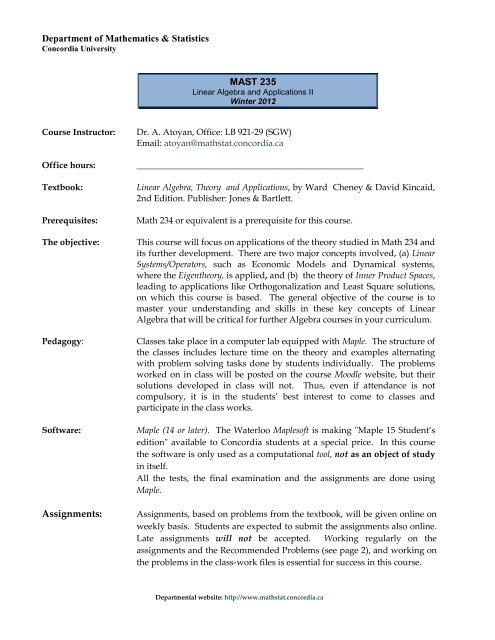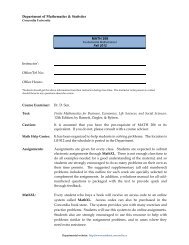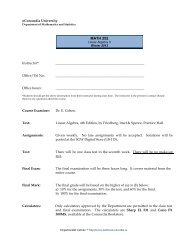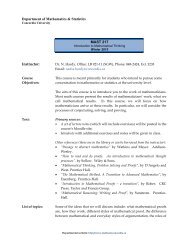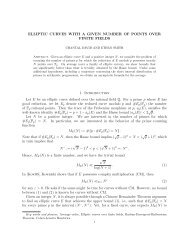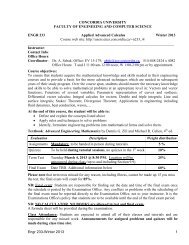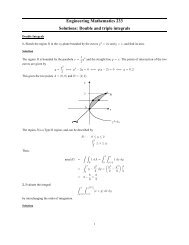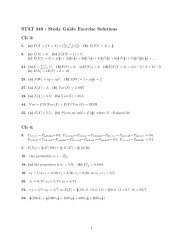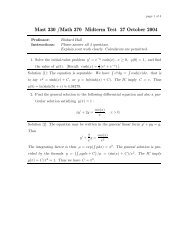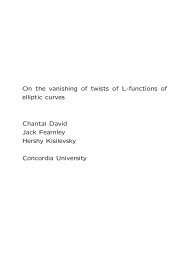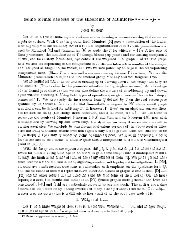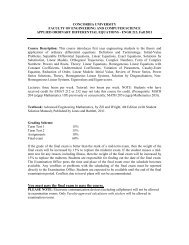MAST 235 - Department of Mathematics and Statistics - Concordia ...
MAST 235 - Department of Mathematics and Statistics - Concordia ...
MAST 235 - Department of Mathematics and Statistics - Concordia ...
Create successful ePaper yourself
Turn your PDF publications into a flip-book with our unique Google optimized e-Paper software.
<strong>Department</strong> <strong>of</strong> <strong>Mathematics</strong> & <strong>Statistics</strong><br />
<strong>Concordia</strong> University<br />
<strong>MAST</strong> <strong>235</strong><br />
Linear Algebra <strong>and</strong> Applications II<br />
Winter 2012<br />
Course Instructor:<br />
Office hours:<br />
Textbook:<br />
Prerequisites:<br />
The objective:<br />
Pedagogy:<br />
S<strong>of</strong>tware:<br />
Assignments:<br />
Dr. A. Atoyan, Office: LB 921-29 (SGW)<br />
Email: atoyan@mathstat.concordia.ca<br />
___________________________________________________<br />
Linear Algebra, Theory <strong>and</strong> Applications, by Ward Cheney & David Kincaid,<br />
2nd Edition. Publisher: Jones & Bartlett.<br />
Math 234 or equivalent is a prerequisite for this course.<br />
This course will focus on applications <strong>of</strong> the theory studied in Math 234 <strong>and</strong><br />
its further development. There are two major concepts involved, (a) Linear<br />
Systems/Operators, such as Economic Models <strong>and</strong> Dynamical systems,<br />
where the Eigentheory, is applied, <strong>and</strong> (b) the theory <strong>of</strong> Inner Product Spaces,<br />
leading to applications like Orthogonalization <strong>and</strong> Least Square solutions,<br />
on which this course is based. The general objective <strong>of</strong> the course is to<br />
master your underst<strong>and</strong>ing <strong>and</strong> skills in these key concepts <strong>of</strong> Linear<br />
Algebra that will be critical for further Algebra courses in your curriculum.<br />
Classes take place in a computer lab equipped with Maple. The structure <strong>of</strong><br />
the classes includes lecture time on the theory <strong>and</strong> examples alternating<br />
with problem solving tasks done by students individually. The problems<br />
worked on in class will be posted on the course Moodle website, but their<br />
solutions developed in class will not. Thus, even if attendance is not<br />
compulsory, it is in the students’ best interest to come to classes <strong>and</strong><br />
participate in the class works.<br />
Maple (14 or later). The Waterloo Maples<strong>of</strong>t is making "Maple 15 Student’s<br />
edition" available to <strong>Concordia</strong> students at a special price. In this course<br />
the s<strong>of</strong>tware is only used as a computational tool, not as an object <strong>of</strong> study<br />
in itself.<br />
All the tests, the final examination <strong>and</strong> the assignments are done using<br />
Maple.<br />
Assignments, based on problems from the textbook, will be given online on<br />
weekly basis. Students are expected to submit the assignments also online.<br />
Late assignments will not be accepted. Working regularly on the<br />
assignments <strong>and</strong> the Recommended Problems (see page 2), <strong>and</strong> working on<br />
the problems in the class-work files is essential for success in this course.<br />
<strong>Department</strong>al website: http://www.mathstat.concordia.ca
<strong>MAST</strong> <strong>235</strong> – Winter 2012<br />
Grade:<br />
Note:<br />
The final grade will be based on the higher <strong>of</strong> (a) <strong>and</strong> (b) below:<br />
(a) 10% for the assignments, 20% for the class test, 10% for 2 quizzes, <strong>and</strong><br />
60% for the final examination.<br />
(b) 100% for the final examination.<br />
There are no supplemental exams for this course.<br />
Week Textbook Course Contents Recommended<br />
Problems<br />
1 Sections 1.3, 2.3, 2.3<br />
LINEAR SYSTEMS:<br />
• Systems <strong>of</strong> Linear Equations (Sec.1.3), <strong>and</strong><br />
Linear Mapping (Sec. 2.3): an Overview<br />
G.Ex. 1.3<br />
# 5, 13, 25, 47, 63<br />
NETWORKS<br />
• Network Problems (Sec. 2.1, pp.99-100)<br />
G.Ex 2.3: 1, 21,39<br />
Gen.Ex. 2.1<br />
# 6, 30, 42<br />
2 Sections 2.4, 6.1<br />
LINEAR SYSTEMS:<br />
ECONOMIC<br />
MODELS<br />
3 Sections 4.1, 4.2/3.2<br />
DETERMINANTS<br />
PROPERTIES &<br />
APPLICATIONS<br />
• Economic Models (pp.177-180, 385-388)<br />
o Theorem 14 (p.177)<br />
o Closed Leontieff Model<br />
o Open Leontieff Model<br />
• Determinants: overview <strong>and</strong> basic properties<br />
• Applications: Coded Messages (p. 281).<br />
o Cramer’s Rule (p.275).<br />
• The Interpolation Problem (pp. 231-233)<br />
• V<strong>and</strong>ermonde matrix (pp. 279-280)<br />
Comp.Ex. 2.4<br />
# 1, 2, 3.<br />
Gen.Ex. 3.2<br />
# 19, 69, 73, 75<br />
Gen.Ex. 4.2<br />
# 7, 27, 33, 45<br />
4 Sections 6.1, 2.2<br />
EIGENTHEORY<br />
AND DYNAMICAL<br />
SYSTEMS<br />
5 Section 7.1<br />
INNER PRODUCT<br />
SPACES<br />
6 Section 7.1<br />
ORTHOGONAL<br />
PROJECTION<br />
7 Section 7.1<br />
SUBSPACES<br />
• Diagonalization <strong>and</strong> powers <strong>of</strong> a matrix (pp. 371-380)<br />
• Application: Dynamical Systems (pp. 380-385).<br />
o Systems with Real eigenvalues<br />
o The Predator-Prey simulation (pp. 125-126)<br />
o Systems with Complex eigenvalues<br />
QUIZ 1 (on Weeks 1-3)<br />
• The concept <strong>of</strong> inner product space over real <strong>and</strong><br />
complex numbers (pp. 403-408)<br />
o Definition<br />
o Properties<br />
• The norm in an inner product space (Theorem 1, p. 409)<br />
o The Cauchy-Schwartz Inequality<br />
o The Triangle Inequality<br />
o The Pythagorean Theorem<br />
• Orthogonality <strong>of</strong> vectors (Theorems 2, 4, pp.411, 412).<br />
• Orthogonal Projection (Theorem 5, p.413)<br />
• Angle (p.415).<br />
• Orthogonal complements (pp. 416-419)<br />
• Orthonormal bases & subspaces , unitary matrices<br />
(pp. 419-423, Theorems 9-15)<br />
Comp.Ex. 2.2<br />
# 1, 2<br />
Comp. Ex. 6.1<br />
# 1, 2, 7, 13<br />
G.Ex. 7.1<br />
# 5, 15, 17, 19,<br />
35, 67, 71, 77<br />
G.Ex. 7.1<br />
# 3, 11, 13, 51, 57<br />
G.Ex. 7.1<br />
# 27, 31, 39<br />
CLASS TEST<br />
MIDTERM on Weeks 1-6.<br />
8 BREAK No classes.<br />
9 Section 7.2<br />
APPLICATIONS OF<br />
ORTHOGONALITY<br />
• The Gram-Schmidt Process (pp.432-439),<br />
Theorems 1 & 2.<br />
G.Ex. 7.2<br />
# 7, 9, 23, 25, 27,<br />
29<br />
Page 2 <strong>of</strong> 3
<strong>MAST</strong> <strong>235</strong> – Winter 2012<br />
10 Section 7.2<br />
LEAST SQUARES<br />
SOLUTION<br />
11 Section 8.1<br />
HERMITIAN<br />
MATRICES &<br />
SELF-ADJOINT<br />
OPERATORS<br />
QUIZ 2<br />
12 Section 8.1<br />
SPECTRAL<br />
THEOREM &<br />
APPLICATIONS<br />
• Normal Equations <strong>and</strong> the Least Squares solutions to an<br />
inconsistent system; Theorem 3. (pp. 439-445)<br />
• Geometrical interpretation <strong>of</strong> the least-square<br />
approximations in terms <strong>of</strong> distance, projections <strong>and</strong><br />
hyperplanes.<br />
• Hermitian matrices, symmetric matrices<br />
• Self-adjoint mappings<br />
• Eigenvalues <strong>of</strong> Hermitian <strong>and</strong> symmetric matrices<br />
QUIZ 2 (on material covered in Weeks 6,7 9, 10)<br />
• Spectral Theorem (Theorems 6 <strong>and</strong> 7)<br />
• Cayley-Hamilton Theorem <strong>and</strong> applications<br />
(pp. 470-472)<br />
G.Ex. 7.2<br />
# 1, 3, 5, 11, 13<br />
G.Ex. 8.1<br />
# 1, 3, 9, 17, 25,<br />
33<br />
G.Ex. 8.1<br />
# 27, 29, 39, 47<br />
13 Sections 8.1, 8.2<br />
QUADRATIC FORMS<br />
SVD FACTORIZTION<br />
• Quadratic Forms<br />
• Singular Value Decomposition (pp. 501-502)<br />
14 REVIEW Review classes for the Final Examination<br />
G.Ex. 8.1<br />
# 11, 61<br />
Page 3 <strong>of</strong> 3


